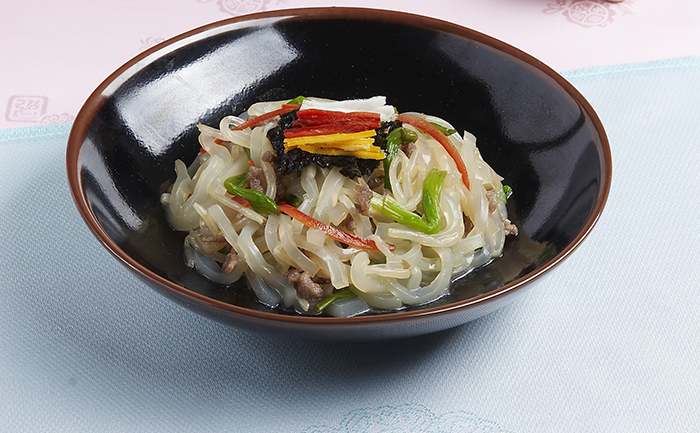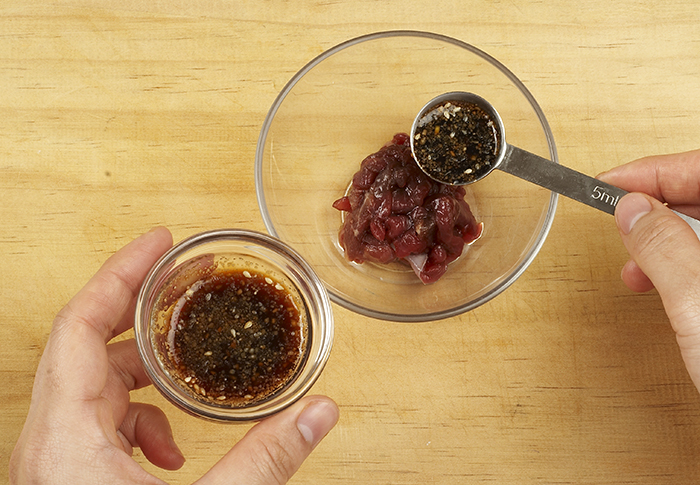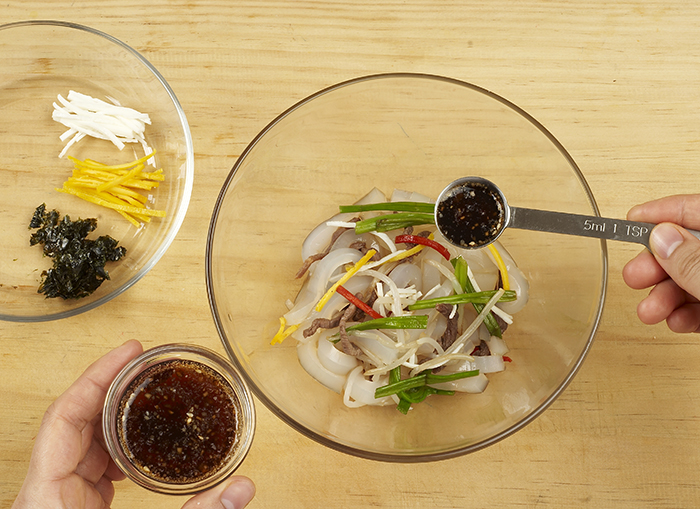Tangpyeongchae is a court cuisine characterized by its colorful appearance and for the harmonious taste created by its ingredients. It's made from mung bean jelly or cheongpomuk (청포묵), beef, watercress, bean sprouts, seaweed and eggs.
The name “tangpyoengchae” (탕평채, 蕩平菜) was created by the 21st king of Joseon, King Yeongjo (영조, 英祖) (1694-1776). The name is derived from the expression tangtang pyeongpyeong (탕탕평평, 蕩蕩平平) which means "being equal without taking any sides." Having experienced severe conflict among political factions, Yeongjo carried out his Tangpyeong Policy to resolve conflict and strife and to pursue harmony across his kingdom. To emphasize the meaning of the policy, he created a dish made from mung bean jelly that was harmonized with the other ingredients and called it tangpyeongchae. He used to eat vegetable dishes, such as tangpyeognchae, every day, and he died at the age of 83, enjoying the longest life of any Joseon king.
Tangpyeongchae is a springtime seasonal dish. The white color of the mung bean jelly is in colorful harmony with the other ingredients. Mung beans contain a lot of essential amino acids and unsaturated fatty acid that help digestion and with the detoxification of accumulated bodily wastes.

** Ingredients
300 grams of mung bean jelly
3 cups of water
1/2 teaspoon of salt
1/2 teaspoon of sesame oil
100 grams of beef (rump preferred)
Marinade:
2 teaspoons of soy sauce
1/2 tablespoon of sugar
1 teaspoon of chopped green onions
1/2 teaspoon of minced garlic
1/2 teaspoon of sesame salt
1/3 gram of ground pepper
1/2 teaspoon of sesame oil
100 grams of bean sprouts
50 grams of watercress
2 cups of water
1 gram of salt
5 grams of red chilies
1 sheet of laver
1 egg
1 teaspoon of canola oil
Seasoned soy sauce:
2 teaspoons of soy sauce
2 tablespoons of vinegar
1 tablespoon of sugar
1 teaspoon of sesame salt
** Preparation
1. Cut the mung bean jelly into "noodles" or strips that are 7 centimeters long and about 1/2 centimeter thick.
2. Clean the blood from the beef. Cut the meat into strips that are 5 centimeters long and 1/3 centimeter thick. Marinate the beef.
3. Remove the tails and heads of the bean sprouts and cut them in strips that are 5 centimeters long and 1/3 centimeters thick. Wash the red chilies and halve them to remove the seeds. Cut the chilies into strips that are 3 centimeters long and 1/3 centimeters wide.
4. Separate the egg white and the yolk and fry each separately. Cut each into strips that are 4 centimeters long and 1/3 centimeters wide.
5. Make the seasoned soy sauce.

** Recipe
1. Boil the water in a pot over high heat for 3 minutes. Add the mung bean jelly when it boils. Poach the jelly for 1 minute. Strain the jelly and season it with the seasoning.
2. Boil water in another pot over high heat for 2 minutes. When it boils, add the salt and bean sprouts and cook for 2 minutes. Add the watercress for 1 minute. Rinse the watercress in water and cut them into strips 4 centimeters long.
3. Preheat a frying pan with canola oil. Stir-fry the beef over a medium heat for 2 minutes.
4. Heat the laver over low heat for 1 minute and crush it all together.
5. Put the jelly, beef, bean sprouts and watercress in a bowl. Add the seasoned soy sauce to the bowl and mix it all together. Add the chilies, laver and egg pieces on top.

Managed by Yoon Sojung
Korea.net Staff Writer
In cooperation with the Institute of Traditional Korean Food (ITKF)
Recipe from “The Beauty of Korean Food: 100 Best-Loved Recipes”
arete@korea.kr
The name “tangpyoengchae” (탕평채, 蕩平菜) was created by the 21st king of Joseon, King Yeongjo (영조, 英祖) (1694-1776). The name is derived from the expression tangtang pyeongpyeong (탕탕평평, 蕩蕩平平) which means "being equal without taking any sides." Having experienced severe conflict among political factions, Yeongjo carried out his Tangpyeong Policy to resolve conflict and strife and to pursue harmony across his kingdom. To emphasize the meaning of the policy, he created a dish made from mung bean jelly that was harmonized with the other ingredients and called it tangpyeongchae. He used to eat vegetable dishes, such as tangpyeognchae, every day, and he died at the age of 83, enjoying the longest life of any Joseon king.
Tangpyeongchae is a springtime seasonal dish. The white color of the mung bean jelly is in colorful harmony with the other ingredients. Mung beans contain a lot of essential amino acids and unsaturated fatty acid that help digestion and with the detoxification of accumulated bodily wastes.

Tangpyeognchae is known for its harmonious taste and the colorful beauty created by the various ingredients and the mung bean jelly. King Yeongjo of Joseon named the dish tangpyeongchae in a wish to pursue harmonized policies across his kingdom.
** Ingredients
300 grams of mung bean jelly
3 cups of water
1/2 teaspoon of salt
1/2 teaspoon of sesame oil
100 grams of beef (rump preferred)
Marinade:
2 teaspoons of soy sauce
1/2 tablespoon of sugar
1 teaspoon of chopped green onions
1/2 teaspoon of minced garlic
1/2 teaspoon of sesame salt
1/3 gram of ground pepper
1/2 teaspoon of sesame oil
100 grams of bean sprouts
50 grams of watercress
2 cups of water
1 gram of salt
5 grams of red chilies
1 sheet of laver
1 egg
1 teaspoon of canola oil
Seasoned soy sauce:
2 teaspoons of soy sauce
2 tablespoons of vinegar
1 tablespoon of sugar
1 teaspoon of sesame salt
** Preparation
1. Cut the mung bean jelly into "noodles" or strips that are 7 centimeters long and about 1/2 centimeter thick.
2. Clean the blood from the beef. Cut the meat into strips that are 5 centimeters long and 1/3 centimeter thick. Marinate the beef.
3. Remove the tails and heads of the bean sprouts and cut them in strips that are 5 centimeters long and 1/3 centimeters thick. Wash the red chilies and halve them to remove the seeds. Cut the chilies into strips that are 3 centimeters long and 1/3 centimeters wide.
4. Separate the egg white and the yolk and fry each separately. Cut each into strips that are 4 centimeters long and 1/3 centimeters wide.
5. Make the seasoned soy sauce.

Clean the blood from the beef. Cut the meat into strips and marinate.
** Recipe
1. Boil the water in a pot over high heat for 3 minutes. Add the mung bean jelly when it boils. Poach the jelly for 1 minute. Strain the jelly and season it with the seasoning.
2. Boil water in another pot over high heat for 2 minutes. When it boils, add the salt and bean sprouts and cook for 2 minutes. Add the watercress for 1 minute. Rinse the watercress in water and cut them into strips 4 centimeters long.
3. Preheat a frying pan with canola oil. Stir-fry the beef over a medium heat for 2 minutes.
4. Heat the laver over low heat for 1 minute and crush it all together.
5. Put the jelly, beef, bean sprouts and watercress in a bowl. Add the seasoned soy sauce to the bowl and mix it all together. Add the chilies, laver and egg pieces on top.

Mix the mung bean jelly, beef, bean sprouts and watercress in a bowl with the seasoned soy sauce. You can add or subtract the sauce according to individual taste.
Managed by Yoon Sojung
Korea.net Staff Writer
In cooperation with the Institute of Traditional Korean Food (ITKF)
Recipe from “The Beauty of Korean Food: 100 Best-Loved Recipes”
arete@korea.kr